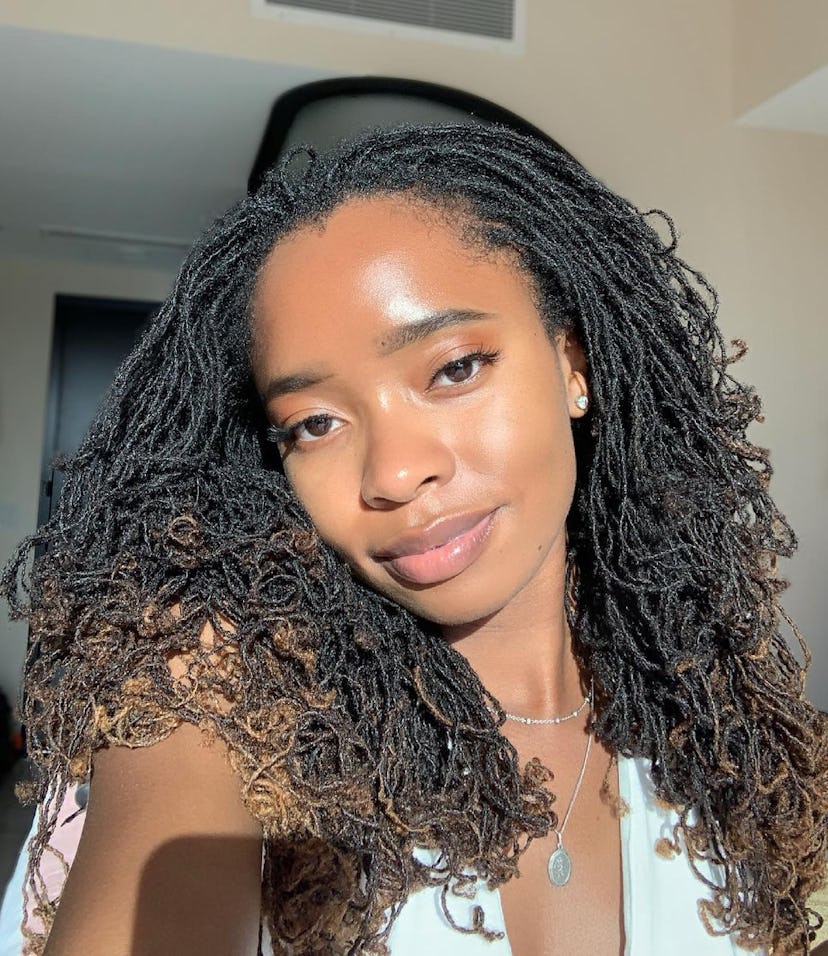(Hair)
Everything You Need To Know About Getting Sisterlocks
Take notes.

Forget a “new year, new me” mindset — the quickest way to hit refresh on your entire aesthetic, regardless of the time of year, is a hairstyle upgrade. Maybe that’s a trendy color or a serious chop you’ve been contemplating for a while. But if you’re after a quick switch-up that delivers length, protection, and customization, few hairstyles rival sisterlocks. Marked by the style’s signature ultra-fine, uniform twists, sisterlocks are a gorgeous choice for anyone looking for natural hair protection while enjoying plenty of movement, length, and color — not to mention the sisterlocks installation is a pretty cool process. Some of the most stylish celebrities have put their own stamp of approval and personal spin on sisterlocks, too, including Ava DuVernay, Lisa Bonet, and Zoë Kravitz.
Originally created by Dr. JoAnne Cornwell back in 1993, sisterlocks — also routinely referred to as microlocks — are installed by parting the hair into a neat, squared-off grid (similar to box braids and many other protective styles) and attaching them to tufts of real hair with a patented tool. With the hairstyle’s popularity rising every year — thanks in large part to how style-able they are — TZR tapped an expert hairstylist to explain absolutely everything you need to know about sisterlocks, all in one place.
How Sisterlocks Work
As is the case with hair color, one of the most crucial steps to getting sisterlocks is an initial consultation with a professional. Unlike many braided styles and twists that can be installed at home with a bit of flexibility and a lot of time, the thin nature of sisterlocks means they require hundreds of pieces — often up to 400 to 600 individual locs — and very small hair squares. Because of how labor-intensive the process is and the high skill level required, it’s best left to a professional, says top-rated stylist and Field Education Leader at Hair Cuttery Starr Mason, who has more than 30 years of professional experience.
At the professional consultation, your stylist will test out a few different sisterlock types to see which pattern works best with your individual hair type, which usually comes down to a matter of thickness. Once you’re both in agreement on the exact type of sisterlocks, the very lengthy installation process begins. Because of the style’s intricacy, expect to be seated in the chair for quite a while — most estimates place your time commitment around 16-hours (broken up into a few different sessions) but can go as long as 36 hours depending on how many individual pieces are used. As you would expect for a style that involved, sisterlock installation prices typically range from $500 to $800 — excluding an initial consultation fee — but can go even higher depending on your location, desired length, and hairstylist’s experience level.
Sisterlocks are ideal for everyone with natural hair. “All natural hair textures can be locked!” Mason assures, though she does add that it’s easiest on coarser textures. “But relaxed hair can be locked as well,” she says. The process also doesn’t damage hair at all, something that Mason says can be chalked up to how well the hair is locked in. “It is not a service that is easy to reverse once the hair is locked,” she says, but it is important to go with a gentle-handed stylist. “You must remember that the locs are using a smaller amount of hair that can be more fragile when creating,” Mason says, “so you need to be careful of that tension when styling.”
Caring For Sisterlocks
The good news is, despite the initial investment cost, Mason tells TZR that sisterlocks can last as long as you want them in — with proper care, that is. When wash day rolls around, try bundling large sections of locs and securing them with a silk or satin hair tie for easier scalp cleansing and added protection. This way, the rubbing motion of washing won’t compromise the integrity of the locs.
Mason says that you’ll want to hit the salon for sisterlock tightening every six weeks or so to maintain them, and it’s a good idea to opt for a professional moisturizing and protein treatment while you’re there to help extend the life of your locs. Fortunately, those tightening sessions aren’t nearly as costly as that first installation, usually running around $100 per visit — though the price is also contingent on the same variables as your initial cost.
Part of the fun of sisterlocks is the unlimited styling possibilities. Curl, braid, dye, or adorn your sisterlocks however you’d like, and you can even trim bits off as your own hair grows or add on extensions for even more length. “It’s a specialty service using a crochet needle that allows you to lock the extension into the existing loc,” Mason explains, and it can breathe new life into even years-old locs.
If you spend enough time in the internet’s most beauty-centric corners, you’ll notice that tons of women with sisterlocks have a date in their social media profiles marking the day they got their locs installed. For many, it’s been years, and a quick scroll through their grids will reveal just how versatile the style can be. If it’s freedom of movement and unlimited possibilities you’re after, it might just be time to join the sisterlocks family once and for all.